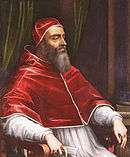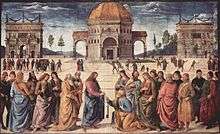1523 papal conclave
The 1523 papal conclave elected Giulio de' Medici as Pope Clement VII to succeed Pope Adrian VI. According to conclave historian Baumgartner, the conclave was the "last conclave of the Renaissance".[1]
| Papal conclave October–November 1523 | |
|---|---|
| Dates and location | |
| 1 October – 19 November 1523 Apostolic Palace, Papal States | |
| Key officials | |
| Dean | Bernardino López de Carvajal y Sande |
| Camerlengo | Francesco Armellini Pantalassi de' Medici |
| Protodeacon | Giulio di Giuliano de' Medici |
| Election | |
| Candidates | Alessandro Farnese, Giulio di Giuliano de' Medici |
| Elected pope | |
| Giulio di Giuliano de' Medici Name taken: Clement VII | |
 | |
Background
Adrian VI experienced ill health during the final months of his life, inspiring the cardinals to begin politicking.[2] Francis I of France had just dispatched a large army into northern Italy in 1522, and expecting to leverage this force to effect the election of French cardinal Jean de Lorraine, or more likely a pro-French Italian cardinal such as Niccolò Fieschi.[2] However, his army experienced a major defeat at the Battle of Bicocca prior to the conclave.[2] In any case, the three French cardinals were ordered by Francis I to rush to Rome.[2]
Charles V, Holy Roman Emperor, strengthened by the Battle of Bicocca, supported Giulio de' Medici, an advocate for imperial policy within the College.[2] Henry VIII of England would have preferred the election of Thomas Wolsey, but was in no position to effect it; Henry VIII sent two letters—one supporting Medici, the other supporting Wolsey—which were to be distributed to the College in that order.[3] The odds against the election finishing before October were given at 60 to 100.[4] The odds were given as 80 to 100 against the conclave finishing in November, and those who took them lost heavily.[4]
The papabile
Gambling on papal elections occurred, and the bookmakers favored Farnese, followed by Medici.[5] Conclave secrecy was non-existent due to the ambassadors who "reported daily" on the balloting and living conditions.[5] Similarly, the law of the conclave requiring the reduction of rations was not followed.[5]
Proceedings

The conclave opened on October 1, with thirty-two cardinals in attendance.[6] Nine cardinals were absent.[7] Baumgartner apparently believes that the only cardinal created by Adrian VI (a fellow Dutchman) [8] was absent, but all the conclave attendance lists show him as participating. Cardinal Giulio de' Medici had sixteen or seventeen supporters; Cardinal Pompeo Colonna had the second most.[9] The "anti-Imperial/anti-Medici" cardinals successfully demanded that the first scrutiny be delayed until the French Cardinals, who were known to be on the way, arrived. On October 6, they appeared, raising the number of electors to thirty-five.[10] Medici drew the lot to have his cell under Christ Giving the Keys to St. Peter, a portrait seen as an omen of election as Julius II had been housed underneath it as well.[5] The remark demonstrates incidentally that the voting was taking place in the Chapel of S. Nicolas and the sleeping quarters were in the Sistine Chapel.
Fieschi was the candidate of the French and received eleven votes; Carvajal (the stalking horse of the Imperial party) received twelve.[5] Both parties switched their support in the next scrutiny with Gianmaria del Monte coming within one vote of election following an accessus.[5] Medici had previously agreed to support del Monte as the final vote, but broke his word and did not come forward.[5]
After the conclave reached its tenth day, Cardinal Thomas Wolsey allegedly received twenty-two votes, although he never received more[5] —conclave mythology of the most unlikely sort.[11] By October 13, the Imperial party started voting for Medici, with the French supporting Farnese.[5] Medici's supporters remained disciplined into November, while the French faction began to crack.[4] Colonna (who despised Medici despite his close ties to Charles V) held a block of four votes against Medici.[4] However, on October 18, when the French faction proposed the candidacy of Orsini (the Colonna family and Orsini family being rivals), Colonna was impelled to throw his support to Medici, giving him twenty votes.[4]
On November 10, Cardinal Ivrea (Ferrero) finally entered the Conclave, having been released from captivity.
Cardinal Giulio de' Medici easily reached the requisite twenty-seven by accessus and took the name Clement VII.[4]
Notes
- Baumgartner, 2003, p. 101.
- Baumgartner, 2003, p. 98.
- Baumgartner, 2003, pp. 98-99.
- Baumgartner, 2003, p. 100.
- Baumgartner, 2003, p. 99.
- Marino Sanuto, I diarii di Marino Sanuto Volume XXXV (Venezia 1892), cols,. 61-62, provides a list of the cardinals who entered conclave on the first of October, from a dispatch of the Venetian Ambassador in Rome: Santa Croce (Carvajal), Volterra (Soderini), Fieschi, Farnese, del Monte, Ancona; De Grassis, Pucci, Medici, Piccolomini, Trani, Della Valle, Cavaillon (Pallavicini), Como (Trivulzi), Colonna, Giacobazzi, Campeggio, Ponzetto, Silvio da Cortona, Armellino. Egidio Canisio, Aracoeli (Numai), Vich, Enckevoirt; Cornaro, Gonzaga, Cibo, Orsini, De Cesis, Caesarino, Salviati, Ridolfi, Rangoni, Trivulzi, and Pisani. Absent, but arriving eventually, were: Auch (Castelnau), Ivrea of Savoy (Bonifacio Ferrero), Lorraine, and Vendôme. Absent were: Crucense (Gurcense: Lang of Salzburg, Archbishop of Gurk), Eboracense (Wolsey), Minerva da Caieta (Cajetan), Magonza (Mainz: Albrecht of Brandenburg), Legre (Liège: Eberhard von der Mark), and Alfonso de Portugal. Three French Cardinals, Auch. Vendôme and Lorraine, entered the Conclave on October 6 (Sanuto, 77).
- The list provided by Foscari (in Sanuto, loc. cit.) gives the absentees as: Crucense (Lang of Salzburg), Eboracense (Wolsey), Minerva da Caieta (Cajetan), Magonza (Mainz: Albrecht of Brandenburg), Legre (Liège: Eberhard von der Mark), and the fratillo of the King of Portugal (Alfonso de Portugal).
- Willem van Enckenvoirt of Urecht: Lorenzo Cardella, Memorie storiche de' cardinali della Santa Romana Chiesa Tomo Quarto (Roma: Pagliarini 1793), 79-80.
- Sanuto, columns 223-224, provides a list of all the Cardinals in attendance and their factional allegiances.
- Sanuto, 61-62: Marco Foscari writes on the 5th of October, 1521, "Gionse li a Roma il secretario dil cardinal Aus francese [that would be Auch] con lettere al collegio di cardinali, soe e di Vendono e Lorena; etiam Cardinali, come erano zonti a Piombino. Poi, a hore 24, si have aviso esser zonti a Civitavecchia, et pregavano li cardinali li volesseno aspectar. Si dice il cardinale Ivrea, che vien per terra, e in camino tre Fiorenza e Siena." Another letter, written on the 6th, is summarized by Sanuto, "Come li 3 cardinali francesi, Aus, Vandomo, et Loreno erano quel zorno a hore 15 zonte in Roma, et intrati in conclavo con li spironi in piedi subito
- Ethelred L. Taunton, Thomas Wolsey: Legate and Reformer (London 1902), 146-147, states that Wolsey received no votes at all. His name is never mentioned in the reports to the Emperor by the Duke of Sessa. Moreover, John Clerk, Bishop of Bath, and Thomas Hannibal, English Ambassadors in Rome, told Wolsey he had no chance and why: "We must shewe your Grace the worst. Many of owr cortyers and also Cardynalles cannot abyde the heryng that any one absent shold be chosyn, for feare of translatyng the See, and other sondry inconvenyentes, whiche ded ensue by the last election; whiche obstakyll we have movyd to your 3 foren [amyd] fryndes, to here there opynyons; who answeryd us quod in [hac] tam recenti plaga suffred by the long absence of the late Elect, your Graces absence semyd to be a great obstakyll: notwithstondyng they sayd that if ther shold be suche discention in the Conclave, so that the cowd not agre upon no man preesent (the lyke wherof was at the last election), then shuld they be fayne to condescend and chose absentem, and wold as lytll regarde the inconvenyentes affore expressyd now, the they dyd at the last election. And fynally, as farre as we can perceyve, the Cardinall of Medices hath a great hope for hymself, and is advised by his fryndes to attempt the fortune for hymself, and so intendith to doo. Next hymself he wyll do for your Grace all that he can, accordyng unto his promes." State Papers, Published under the Authority of Her Majesty's Commission Volume VI, King Henry VIII Part V (1849), p. 176.
References
- Baumgartner, Frederic J. 2003. Behind Locked Doors: A History of the Papal Elections. Palgrave Macmillan. ISBN 0-312-29463-8.
- Ferdinand Gregorovius, The History of Rome in the Middle Ages (translated from the fourth German edition by A. Hamilton) Volume 8 part 2 [Book XIV, Chapter 5] (London 1902) 449-450; 453-458.
- F. Petruccelli della Gattina, Histoire diplomatique des conclaves Volume I (Paris: 1864), 531-557 (featuring English and Florentine documents).
- Sede Vacante of 1523. Dr. J. P. Adams